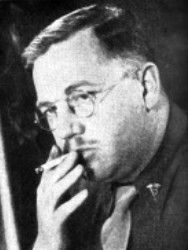In that position, on D-Day, 6 June 1944, Maj Tegtmeyer’s unit was in action against German forces during the invasion at Normandy, France. The 1st Infantry Division and one regimental combat team from the 29th Infantry Division comprised the first wave of troops that assaulted German Army defenses on Omaha Beach on D-Day. The 1st Division had to run 300 yards to get to the bluffs, with some of the Division's units suffering 30 percent casualties in the first hour of the assault. When Maj Tegtmeyer landed with his Medical Section, the assaulting troops were still pinned down on a narrow beachhead and, due to the devastating German fire, numerous casualties had been sustained. Ignoring his own safety, Maj Tegtmeyer covered the length of the beach, administering aid to the wounded lying all along the shore. Over and over, Maj Tegtmeyer went into the mine-strewn waters and pulled the wounded to comparative safety behind a shale barrier. Despite the heavy fire, Maj Tegtmeyer unceasingly rendered aid to the wounded under the most hazardous conditions. Maj Tegtmeyer’s personal bravery, courageous actions, devotion to duty and extraordinary heroism that day earned him the U.S. Army's second highest award for valor, the Distinguished Service Cross.
Dr. Tegtmeyer remained in the Army after the war, completed the Medical Field Service School Hospital Administration course in 1955 and received his MA degree in Hospital Administration from Baylor University in 1956. He was Deputy Commander, US Army Medical Services Combat Development Group at Walter Reed Army Medical Center in the late 1950s and early 1960s. Tegtmeyer was promoted to rank of Colonel on 10 March 1959. He was assigned as a Medical Faculty Member of the US Army Chemical School at Fort McClellan, AL, when he suffered a heart attack and died on 9 September 1963.
Medals, Awards and Badges: Distinguished Service Cross, Silver Star Medal with Bronze Oak Leaf Cluster, Legion of Merit, Bronze Star Medal with 4 Bronze Oak Leaf Clusters, Purple Heart, Army Commendation Medal, American Defense Service Medal, American Campaign Medal, European-African-Middle Eastern, Campaign Medal with Arrowhead Pin Silver and 3 Bronze Stars, World War II Victory Medal, Army of Occupation Medal, National Defense Service Medal, Croix de Guerre with Palm (France) 2 Awards, Presidential Unit Citation, and Combat Medical Badge
Contributor: SBR (49039178)
In that position, on D-Day, 6 June 1944, Maj Tegtmeyer’s unit was in action against German forces during the invasion at Normandy, France. The 1st Infantry Division and one regimental combat team from the 29th Infantry Division comprised the first wave of troops that assaulted German Army defenses on Omaha Beach on D-Day. The 1st Division had to run 300 yards to get to the bluffs, with some of the Division's units suffering 30 percent casualties in the first hour of the assault. When Maj Tegtmeyer landed with his Medical Section, the assaulting troops were still pinned down on a narrow beachhead and, due to the devastating German fire, numerous casualties had been sustained. Ignoring his own safety, Maj Tegtmeyer covered the length of the beach, administering aid to the wounded lying all along the shore. Over and over, Maj Tegtmeyer went into the mine-strewn waters and pulled the wounded to comparative safety behind a shale barrier. Despite the heavy fire, Maj Tegtmeyer unceasingly rendered aid to the wounded under the most hazardous conditions. Maj Tegtmeyer’s personal bravery, courageous actions, devotion to duty and extraordinary heroism that day earned him the U.S. Army's second highest award for valor, the Distinguished Service Cross.
Dr. Tegtmeyer remained in the Army after the war, completed the Medical Field Service School Hospital Administration course in 1955 and received his MA degree in Hospital Administration from Baylor University in 1956. He was Deputy Commander, US Army Medical Services Combat Development Group at Walter Reed Army Medical Center in the late 1950s and early 1960s. Tegtmeyer was promoted to rank of Colonel on 10 March 1959. He was assigned as a Medical Faculty Member of the US Army Chemical School at Fort McClellan, AL, when he suffered a heart attack and died on 9 September 1963.
Medals, Awards and Badges: Distinguished Service Cross, Silver Star Medal with Bronze Oak Leaf Cluster, Legion of Merit, Bronze Star Medal with 4 Bronze Oak Leaf Clusters, Purple Heart, Army Commendation Medal, American Defense Service Medal, American Campaign Medal, European-African-Middle Eastern, Campaign Medal with Arrowhead Pin Silver and 3 Bronze Stars, World War II Victory Medal, Army of Occupation Medal, National Defense Service Medal, Croix de Guerre with Palm (France) 2 Awards, Presidential Unit Citation, and Combat Medical Badge
Contributor: SBR (49039178)
Gravesite Details
US ARMY, Date interred: 9/13/1963
Sponsored by Ancestry
Advertisement
Advertisement









